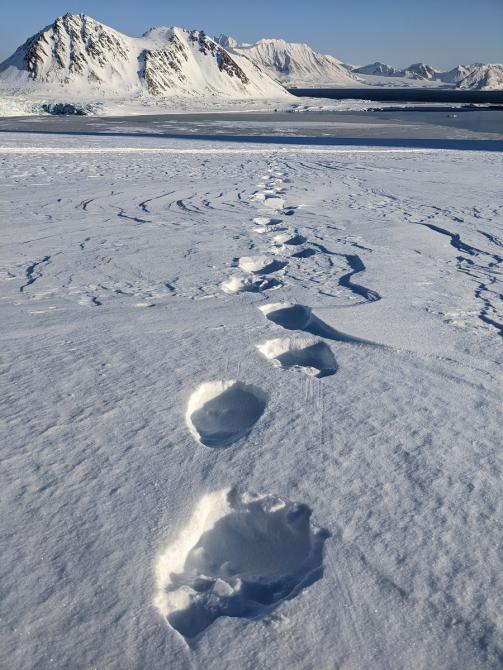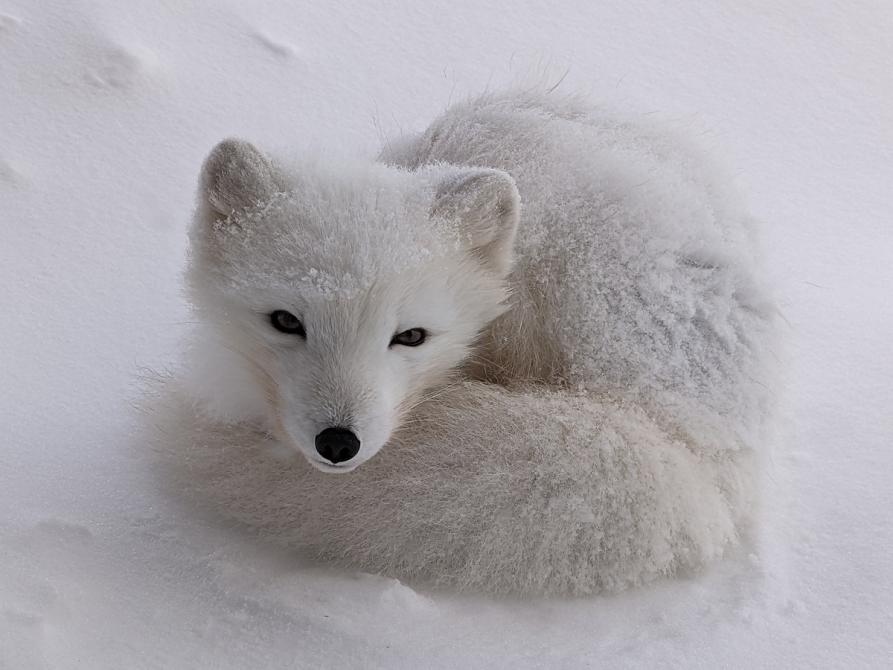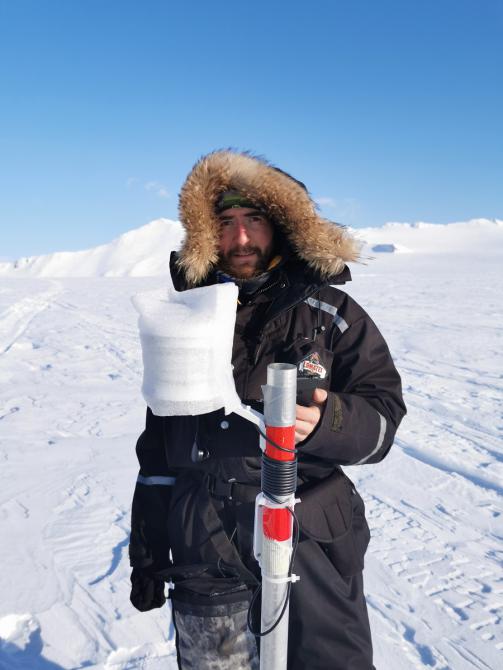| Małgorzata Kłoskowicz |
Although it has been studied for more than 50 years, it still holds many secrets. Scientists, conducting field measurements, collected various information about the over 600-year-old mass of ice. On this basis, they performed geomorphological, hydrological and glaciological analyses. However, much of this data was unavailable due to the lack of harmonisation of various measurements, e.g. snow cover. This challenge was faced by a team of scientists led by Michał Laska, PhD, from the University of Silesia. The results of the work were published at the end of 2022 in the “Scientific Data” journal.
Field research in Spitsbergen? For many employees or doctoral students of the Faculty of Natural Sciences of the University of Silesia, it is a unique way of conducting research, and the best adventure of life. “If any of us were going on a polar expedition, we tried to collect as much data as possible. It didn’t matter if they were directly used in our research. We just knew that the time spent among the glaciers should be used in the best possible way” says Michał Laska, PhD, participant of fourteen polar expeditions.
Therefore, various data on the environment of Spitsbergen were added each year. Over time, they constituted quite a substantial and interesting base of knowledge about this geographical region. It could be used by hydrologists, geologists, glaciologists and ecologists from around the world. It could, except for one problem. Snow cover information collected over more than 30 years was not entirely consistent, and this inconsistency had many reasons. As the glaciologist admits, data has been collected over the years with the use of various methods and tools, using unequal classifications of the physical characteristics of the snow cover. The experience of the researchers was also of great importance, as sometimes various errors or inaccuracies could occur. There were also a lot of parameters. “I was primarily interested in the snow data from the Hans Glacier. We were receiving more and more requests to make them available for various publications and research projects. They were available and not available at the same time. It did not like it. Finally, I decided to face this problem” says the scientist from the University of Silesia.
He undertook this difficult task together with a team of scientists from: the Institute of Geophysics of the Polish Academy of Sciences, the Institute of Biochemistry and Biophysics of the Polish Academy of Sciences, the University of Wrocław and the Jagiellonian University. The information concerned the Hans Glacier and came from the years 1989-2021. The work on the development of substantial material took many months. The data was standardised to modern protocols and the international snow classification proposed by Charles Fierz’s team in 2009. Michał Laska, PhD, emphasises how important it will be to develop the database by subsequent generations of researchers in accordance with the proposed model.

“The data was collected in accordance with three classifications. What is interesting, the first of them was the original idea of prof. Marian Pulina, prof. Piotr Głowacki and Jan Leszkiewicz, PhD. It took us some time to find a common ground between this idea and later international solutions. The notes of the observers, who in the transitional years carried out measurements using several classifications at the same time, were very helpful” explains Michał Laska, PhD. Systematic observations of the condition of the Hans Glacier began in 1989. Scientists were primarily interested in what was happening to the ice mass, whether it was increasing or rather decreasing, and at what rate individual processes were taking place.
The basic parameter in this type of analysis is the measurement of snow density, which can be performed in various ways. The value of the snow density combined with the height of the snow cover allows you to calculate how much fresh water is actually hiding in this huge reservoir.
“This is an important topic from the human perspective, because without drinking water we will not survive on Earth” emphasises the scientist. He adds that the aforementioned parameter of snow density is an interesting example, because many papers or scientific projects have been published on the subject of its harmonisation.
“It appears that it is enough to weigh a sample of a certain, known volume, and we get the result immediately. The truth is, every time we use different measuring instruments, we can get a different measurement!” explains the glaciologist.
What’s more, the thickness of the snow cover and other physical characteristics of the snow, such as grain size, hardness, moisture and temperature of the snow, are also important. Scientists need to pay attention to whether they are dealing with fresh snow, i.e. low-density snow powder, or a compact, high-density structure. Hence, there were many difficulties related to the unification of data.
Descriptions in which the subjective assessment of observers was also a great challenge, and there were at least a dozen of them over the thirty years analysed. For people who do not work with snow measurements on a daily basis, for example, the description of the shape of snow grains may be ambiguous, even if there are only nine basic classes in the basic classification.

“Snow is a very specific matter. It is characterised by the highest reflectivity among the natural elements of the natural environment. This is a parameter called albedo. It means the ratio of solar radiation reflected from the surface – in this case, snow. There is no natural element that would achieve higher albedo values than freshly deposited snow, and these reach even 90% – says the scientist.
Glaciers are therefore a kind of thermoregulator of our climate. It is worth adding, however, that this mass of ice also contains contamination. For many years, there were active mines in Svalbard, for example, the surface of the snow was covered with soot. Thus, the cover became darker and lost its original properties of reflecting solar radiation at the highest possible level. This in turn meant an accelerated melting process and the release of more water into the ecosystem. The glaciologist also draws attention to the dust that reaches Svalbard from various parts of the world, e.g. from the Sahara or from Siberian taiga fires, and settles on the surfaces of the ice masses. This also speeds up the melting process. Currently, Michał Laska, PhD, is implementing an interdisciplinary project investigating the secondary circulation of pollutants originating from glaciers and entering the natural environment.
The colour of the snow is therefore important, but this information is not provided in the measurements of the physical characteristics of the snow cover. It would be too subjective. Color changes are therefore described as the consequences of snow cover metamorphosis.
“The Hans Glacier is a unique object. It may not be the longest-observed glacier in Svalbard, but more than 30 years of data collection have made it one of the reference objects of key importance for understanding changes in the modern climate. It is a medium-sized object, corresponding to 1/3 of the area of Katowice. Its head flows directly into the Hornsund Fjord” says the scientist from the University of Silesia.
It was the first glacier that Michał Laska, PhD, encountered in his research work. “I have been conducting my research on Svalbard since 2010. You can see with the naked eye how the head of this huge ice mass is retreating year after year. The conclusions are sad, and the view is depressing” admits the glaciologist.
Mass loss, especially in recent years, has been exceptionally high due to record-breaking heatwaves hitting the archipelago. It’s easy to imagine what happens to ice at 21°C.
“I don’t think I’m going to surprise anyone by talking about the future of the Hans Glacier. Svalbard is in the fastest-warming region of the world. If the trend of change continues, the Hans Glacier as we know it will virtually disappear, like many other glaciers in the region. Everything indicates that in the coming decades we will also have to say goodbye to glaciers in Africa and more glaciers in the Alps. So what to do? We must take all measures to delay these drastic changes, thus giving ourselves time to prepare for the new conditions in which we will live” concludes the scientist.
You can read about the effects of work aimed at unifying data on the snow cover of the Hans Glacier in the article Hansbreen Snowpit Dataset – over 30-year of detailed snow research on an Arctic glacier published in 2022 in the “Scientific Data” journal.
The article “The Hans Glacier is a unique object” was published in the January issue of “Gazeta Uniwersytecka UŚ” 4(304).
Michał Laska, PhD | photo: Dariusz Ignatiuk






